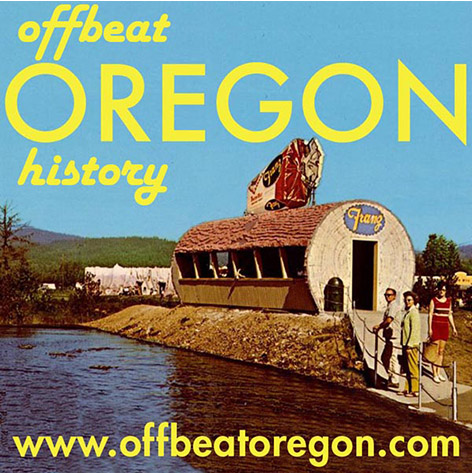MILWAUKIE, CLACKAMAS COUNTY; 1940s:
Buying gas-station B-17 was a crazy adventure
Audio version: Download MP3 or use controls below:
|

So down came Art Lacey in his new, doomed warbird, landing in a shower of sparks with a screech of tearing metal.
ALTHOUGH THE CAT was now out of the bag, the manager felt bad about the broken landing gear — and probably a little relieved, too, since his customer wasn’t dead. “He turned to his secretary and said, ‘Have you written up the bill of sale yet on that B-17?’” Punky recounted. “And she said no, and he said, ‘Worst case of wind damage I’ve ever seen.’ And so he sold him a second B-17.” The second plane set Art back just $1,500 — a special deal the manager made him, knowing he’d spent all his money on the first one. Of course, faking the copilot was no longer going to work, so Art called his wife long-distance and asked her to send two of his friends down with a case of whiskey. The booze was to be used to bribe the local fire department to pump the fuel out of the old B-17 and into the new one using their fire truck, and it was a powerful enticement; Oklahoma was still a dry state at the time. Everything worked as planned, although Art had to kite a check in Palm Springs to refuel the big plane; luckily, he made it home to cover his paper before it could bounce. But when he got home, Art found his troubles had just begun. The city of Portland wouldn’t issue permits to bring the plane from the airport. It was just too big, even after the wings were dismantled. But Art was in so deep now, there was no turning back. He scheduled the move for the dark of night, well after the bars had all closed. He hired two teenagers with hot cars to accompany the motorcade, with instructions to floor it and race off recklessly into the night if the police should appear — the idea being to draw the cops away from the plane. The truck drivers were instructed that under no circumstances were they to stop before they arrived at the gas station, no matter who ordered them to. And he promised to pay any tickets anyone was written by any cop for his or her part in the move. The move’s only mishap was a drunk driver who, seeing an airplane bearing down on him, thought he’d accidentally driven out onto an airfield and panicked and skidded into the ditch.
CITY HALL OFFICIALS were, of course, furious. But after their initial attempts to punish Art resulted in some very unflattering newspaper coverage, they gave it up, fined him $10, declared victory and went home. Art was able to pay half his fine with the $5 collected from his friend. He promptly had his airplane mounted above the gas pumps and renamed the place “The Bomber.” And there it sat for the next 63 years, bringing in hundreds of thousands of curious gawkers and customers alike. Over the years the Laceys added a restaurant and a small hotel. In the early 1990s they closed the gas pumps, and the big B-17 started to look increasingly forlorn up there, exposed to the weather and the occasional predations of vandals. Then, in 1996, the family decided to do something about it — and the B-17 Alliance was born, dedicated to restoring the “Lacey Lady,” as they’ve dubbed the bomber. Currently the bomber is in the B-17 Alliance Museum and Restoration, located at McNary Airfield in Salem (3278 25th St. SE). The museum is open Fridays through Sundays from 10 a.m. to 2 p.m. The multi-million-dollar restoration still has a ways to go before it’s successfully completed, and the Alliance is working to raise the necessary funds to get it done; when it is, the Lacey Lady will be one of just seven B-17s remaining in flyable condition. Full details of their project are at www.b17alliancegroup.com.
|
Background photo is a hand-tinted image of the Conde McCullouch-designed bridge over the Willamette at Oregon City, published circa 1930 on a picture postcard.
Scroll sideways to move the article aside for a better view.
Looking for more?
On our Sortable Master Directory you can search by keywords, locations, or historical timeframes. Hover your mouse over the headlines to read the first few paragraphs (or a summary of the story) in a pop-up box.
... or ...

©2008-2016 by Finn J.D. John. Copyright assertion does not apply to assets that are in the public domain or are used by permission.

